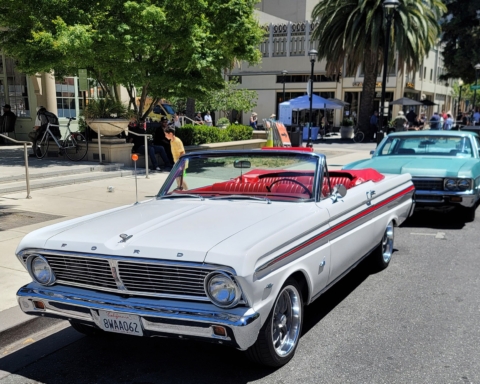A super-secret stealth ship called the Sea Shadow, a vessel with slanted sides designed to deflect radar probes, was built in Redwood City during the Cold War.
The Sea Shadow’s name was somewhat of a misnomer in that it sailed mainly at night and, hidden by darkness, could not cast a shadow. If all this cloak-and-dagger intrigue wasn’t enough, the boat was assembled inside another top-secret ship, a submersible barge used in one of the Cold War’s more interesting episodes. The barge took part in Operation Jennifer, a CIA attempt to raise a sunken Soviet submarine in an effort to recover code books and other valuable intelligence items.
The 164-foot-long Sea Shadow, the inspiration for the bad guy’s seagoing lair in the James Bond film “Tomorrow Never Dies,” was built by Lockheed Martin inside the barge following the clandestine Jennifer episode in the 1970s that reportedly obtained at least part of the Russian submarine from the Pacific Ocean, about a thousand miles from Hawaii.
The twin-hulled Sea Shadow, which looked like an A-frame houseboat, was under wraps until 1993 when it was unveiled to wide media coverage. The ship became so “unsecret” there is now a plastic model kit available of the vessel, which had a speed of 10 knots and a crew of 10.
According to a Lockheed Martin account of the sea trials in 1981, the crew discovered the vessel’s motor propellers were improperly installed. “They quickly corrected the problem and continued to make progress, proving the ship’s capabilities,” the company report stated. The installation error caused the Sea Shadow to produce unexpectedly large wakes that were easy to spot on radar and from the air.
The Sea Shadow never sailed beyond testing. The company account reported the ship’s technologies were applied to parts of submarines as well as the Navy’s new class of destroyers. The sleek, sloped sides inspired by the Sea Shadow are seen in superstructures of many of today’s Navy ships. Old salts, who sailed when “bulkheads” were at right angles, could testify to the structural changes.
During the tests, the Sea Shadow was launched from the barge into darkness. “We operated during the night with impunity,” a crewmember told the Washington Post. “We could disappear and sneak up on whomever we wanted. Nobody thought we could do that.” The sailor recalled watching a glass of soda on the bridge barely ripple as the Sea Shadow rolled through 12-foot waves.
Both the Sea Shadow and its mother barge, which resembled a floating airplane hangar crossed with a drive-in movie screen, would go on to spend years as part of the mothballed Reserve Fleet near Suisun City.
The Navy tried to sell the Sea Shadow or even give it away to a museum but there were no takers and it was sold for scrap in 2012. During the effort to rid itself of the once-secret ship, the Navy public affairs people were very forthcoming with information about the Sea Shadow. For instance, a Navy news release in 2003 revealed the barge would leave Redwood City and “go out to sea in the dead of night and, halfway submerged, let the Sea Shadow out to be tested without being overly exposed to public observation.”
The Sea Shadow “was never intended to be mission-capable,” said Paul Charterton of the Naval Sea Systems Command, noting that it lacked traditional rudders and instead relied on stabilizers to control steering. The Navy billed the vessel as “the premier test platform for ship stealth and experimental technologies.” So, the Sea Shadow ended up on the scrap heap, but what of the barge? When last heard from, it was being used by Bay Ship & Yacht, a private company based in Alameda, as a floating dry-dock. According to a company statement, the vessel is “the only covered dry-dockon the West Coast,” adding that it can handle vessels with a beam of 76 feet.






